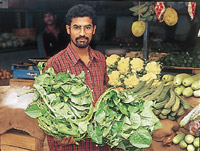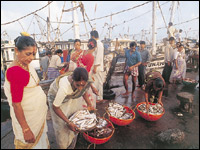


 To Market, To Market, To Buy Whatever You May Please!
To Market, To Market, To Buy Whatever You May Please!
The market places of Mangalore city are where the great food ideas in most people�s homes first originate. Some of the best vegetables, fruits, fish and dry fish markets in all of South India are to be found in this gourmet city, discovers UpperCrust. |
|
�IF you want to see tourist attractions, you must go to Bangalore, but if you want to experience some of the finest markets in South India, you must see Mangalore,� is the sound advice locals give first-timers to the old port city on the south-west coast. �It is not as if Mangalore does not have popular tourist attractions, we do, like the Gokaranantha Temple, the 11-metre high statue of Lord Bahubali in Venur, the Aloysius Chapel and the Panambur Beach, but only our markets are more colourful, with plenty of character and give a better idea of what Mangalore is all about.�
Indeed, they do! Like the sprawling vegetables and fruit market in what is simply known as Market Area in central Mangalore. Yes, jackfruit and banana are treated as vegetables in Mangalore. The merchants encourage buyers with hoarse cries to pick them up, offering friendly advice on the shelf life of each veggie, and how best to put them to the pot. Basele is the local spinach. A creeper-like vegetable that is wrapped around in the form of a wreath and sold cheaply. Cheaply, because Basele grows wild. Almost anybody can avail of this tasty green if they have a garden and have the inclination. Some merchants sell the Kokum fruit whole. And some sell the Arecanut fruit whose yield gives supari. Rainy season mangoes are in season and so is the papaya, in various sizes, and sweet cucumber. Mangalorean men making their Sunday morning purchases, hitch up their mundus and go next to buy plantain leaves, on which they will have their lunch.
A little further down the Market Area road, and to the rear of the vegetables and fruit markets, almost as if shunned because of the stink, is the dry fish market of Mangalore.
Dry fish is a big business during the monsoon. The last fading days of summer are spent drying and salting a catch large enough to last the city out through the rains. This is done on a huge sand bar in a dry fish yard in Bengere across the Netravati River that flows through the city.
Sardine, Mackerel, Shark, Shrimps are all dried for up to a week, then packed away in salt, and kept for sale and export during the rains. Dry fish curries are easy to make, and so are the But the true feel, sound and smells of a market comes across best in the big fish market of the city, that is down by the water front, on the Old Port Road. It is vast. And extremely busy in the early hours of morning. Fishing trawlers come up to the wharf and unload their catch of the previous night. Teams of relay runners, men and women, each holding a basket between them, convey this fish to the open-air market where on-the-spot auctions are held. The fish is bought, it is stacked in ice right there, and then carted away for distribution. Auctions are briskly and hotly held with raised voices and fierce arguments breaking out frequently. They buyers are hotel and restaurant people, and individuals who fancy fish and intend to stock up the fridge at home with a week's supply.
The ice machines cut through huge blocks of ice, sending a cold shower of slivers all around, and fishermen but this by the bucketful. The auctioned fish is packed in this ice and stored in lorries from out of city and state, that then wait for the port
authority to lift his yellow and black metal arm and let them trundle their merchandise out.
|

Home Page
About the mag
Subscribe
Advertise
Contact Us
 It is a rambling old ground floor structure built probably of limestone and whitewashed several times over since then. Under a huge roof that spreads over the market like a circus tent, sit the vegetable and fruit merchants in their individual stalls. Business is always brisk. And the best buys in the vegetable section at this time of the year are the jackfruit and banana, local spinach, and the big green aubergine.
It is a rambling old ground floor structure built probably of limestone and whitewashed several times over since then. Under a huge roof that spreads over the market like a circus tent, sit the vegetable and fruit merchants in their individual stalls. Business is always brisk. And the best buys in the vegetable section at this time of the year are the jackfruit and banana, local spinach, and the big green aubergine.
 coconut-based chutneys, the shrimp powders that go well with rice.
Nobody knows this better than the multi-national Hindustan Levers Limited which is one of the major players of the dry fish export market in Mangalore.
coconut-based chutneys, the shrimp powders that go well with rice.
Nobody knows this better than the multi-national Hindustan Levers Limited which is one of the major players of the dry fish export market in Mangalore.
 It is one, big smooth operation. And to the outsider, a lot of fun. The trawlers tooting in slowly with their colourful flags flapping in the wind make a lovely picture. And the fisherwomen, bashful but happy to be photographed as they join the men, muscle and sinew straining, to unload the catch. There is among them the individual entrepreneur who sees opportunity in a pair of wriggling lobster. This is a costly delicacy and if sold to the right party, might fetch enough of a profit for one day. Such sales are carried out in small offices belonging to seafood contractors over a glass of fishy tea. The contractors have a bench and table in an ice room. And a telephone. Calls come in from restaurateurs. �Do you have Cod fish?� �Yes!� �In quantity?� �How many do you want?� �Two dozen.� �Yes!� And then the haggle over prices.
It is one, big smooth operation. And to the outsider, a lot of fun. The trawlers tooting in slowly with their colourful flags flapping in the wind make a lovely picture. And the fisherwomen, bashful but happy to be photographed as they join the men, muscle and sinew straining, to unload the catch. There is among them the individual entrepreneur who sees opportunity in a pair of wriggling lobster. This is a costly delicacy and if sold to the right party, might fetch enough of a profit for one day. Such sales are carried out in small offices belonging to seafood contractors over a glass of fishy tea. The contractors have a bench and table in an ice room. And a telephone. Calls come in from restaurateurs. �Do you have Cod fish?� �Yes!� �In quantity?� �How many do you want?� �Two dozen.� �Yes!� And then the haggle over prices.